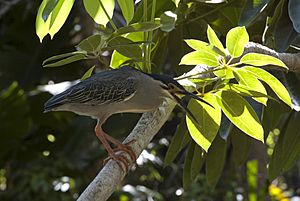Striated heron facts for kids
Quick facts for kids Striated heron |
|
|---|---|
 |
|
| An adult Striated Heron in Laem Pak Bia, Thailand. | |
| Conservation status | |
| Scientific classification | |
| Genus: |
Butorides
|
| Species: |
striata
|
| Synonyms | |
|
|
The striated heron (Butorides striata) is a small bird, about 44 centimeters tall. It is also known as the mangrove heron, little heron, or green-backed heron. These herons usually do not migrate, meaning they stay in the same area all year. They are known for some interesting behaviors.
Striated herons live in small wetlands in many parts of the world. You can find them in tropical areas from West Africa to Japan and Australia. They also live in South America. Sometimes, these birds fly to faraway islands, like Chuuk and Yap in Micronesia, the Marianas, and Palau.
For a long time, people thought this bird was the same as the green heron from North America. But now, scientists usually consider them different species. The lava heron from the Galápagos Islands is also a close relative. All these birds were once called "green-backed herons" together. You can also find the striated heron in Bolivia, especially near the town of Riberalta in the Aquicuana Reserve.
Contents
What Does a Striated Heron Look Like?
Adult striated herons have a blue-grey back and wings. Their undersides are white. They have a black cap on their head and a dark line that goes from their beak to under their eye. Their legs are short and yellow. Young herons look a bit different. They are browner on top and have streaks on their undersides.
How Do Striated Herons Hunt?
These birds are very patient hunters. They stand very still at the edge of the water. They wait to surprise their prey. They mostly eat small fish, frogs, and water insects.
Striated herons are also clever. They sometimes use bait to catch fish. They might drop a feather or a leaf onto the water. When small fish come to check it out, the heron quickly snatches them! This makes them easier to spot than some other small herons.
Nests and Eggs: The Striated Heron's Home
Striated herons build their nests from sticks. The sticks are usually 20–40 centimeters long and very thin. The whole nest is about 40–50 centimeters wide and 8–10 centimeters high. Inside, there's a dip about 20 centimeters wide and 4–5 centimeters deep.
They usually build their nests in bushes or trees, not too high off the ground. Sometimes, they even build them in safe spots on the ground, often near water. A female heron usually lays 2 to 5 eggs. The eggs are pale blue and measure about 36 by 28 millimeters.
Interesting Behaviors of Herons
One time, an adult heron was seen doing something very strange while on its nest. It grabbed a stick with its beak. Then, it moved its head back and forth very quickly, like a sewing machine needle. No one knows why the bird did this. Other birds sometimes make similar movements to pack down their nest or move their eggs. They might also do it to get rid of tiny bugs. But for this heron, it didn't seem to be for those reasons.
Young herons have a special way of acting when they feel scared. They stretch out their necks and point their beaks straight up to the sky. It's not clear if this helps scare away animals that might try to eat them.
Conservation Status
The striated heron is a widespread bird. It is also generally common in many places. Because of this, the IUCN says it is a species of "Least Concern". This means that scientists are not worried about it becoming endangered. This is true even if the lava heron is considered part of the same species or not.
Images for kids
-
A Striated Heron on the Daintree River, North Queensland.
See also
 In Spanish: Garcita azulada para niños
In Spanish: Garcita azulada para niños









